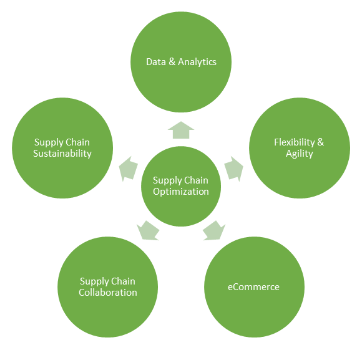Navigating the Future: Supply Chain Optimization Part 1

Welcome back to our series on Supply Chain Trends! In our previous posts, we explored the latest trends in technology, manufacturing, warehousing, logistics, and fulfillment. Now, let’s dive into the critical topic of supply chain optimization, which we’ll explore over two insightful parts.
Supply chain optimization is a strategic approach aimed at enhancing the efficiency and effectiveness of a company’s supply chain operations. This optimization can be grouped into several key disciplines:
- Data & Analytics
- Flexibility & Agility
- eCommerce
- Supply Chain Collaboration
- Sustainability

In this first installment, we’ll delve into the trends driving optimization within Data & Analytics and Flexibility & Agility. Stay tuned for our follow-up post where we will explore eCommerce, Supply Chain Collaboration, and Sustainability.
Data & Analytics: Transforming Supply Chain Management
Data and Analytics play an increasingly crucial role in organizational efforts to optimize supply chains. By using advanced analytical techniques to process and interpret vast amounts of data from various supply chain activities, companies can improve efficiency, reduce costs, enhance decision-making, and facilitate collaboration. Here are three key trends in data and analytics driving supply chain optimization:
-
The Power of Predictive Analytics
Imagine being able to predict future demand accurately, ensuring you always have the right inventory at the right time. This is the power of Predictive Analytics. Using advanced algorithms and AI, predictive analytics allows companies to forecast demand, optimize inventory, reduce operational costs, and enhance logistics. Companies like DHL, UPS, and Amazon are already reaping the benefits.
-
Harnessing Big Data
Big Data is revolutionizing supply chain management by providing actionable insights from vast amounts of data. By analyzing real-time data from various sources, companies can make more informed decisions, predict demand accurately, and streamline their processes.
-
Embracing Digital Supply Chain Twins
A Digital Supply Chain Twin is a virtual simulation of your physical supply chain, allowing you to test scenarios and predict outcomes. This technology helps organizations understand the impact of decisions and disruptions, enabling more resilient and efficient operations. Companies like PepsiCo and General Motors are leading the way with this innovative technology.
Flexibility & Agility: Adapting to a Dynamic Market
Flexibility and Agility are essential for modern supply chains, enabling them to respond swiftly to market changes and customer demands. Here are seven strategies being pursued to enhance flexibility and agility in supply chains:
-
Supply Chain as a Service (SCaaS)
Outsource your supply chain management with Supply Chain as a Service (SCaaS), and focus on your core competencies while enjoying improved efficiency and reduced costs. Giants like Amazon and Hewlett Packard are already leveraging SCaaS to streamline their operations.
-
Elastic Logistics for Dynamic Markets
In today’s fast-paced market, flexibility is key. Elastic Logistics allows your supply chain to scale up or down swiftly in response to demand changes, enhancing efficiency and customer satisfaction.
-
Synchronization-Integration for Seamless Operations
Bridge the gap between your supply chain operations, multi-functional processes, and people systems with Synchronization-Integration. This strategic approach helps manage inventory with precision and improves overall efficiency.
-
Adapting to Rapid Product Life Cycles
With the rapid evolution of product life cycles, especially in sectors like electronics and apparel, supply chains must be agile and efficient. This adaptability is crucial for staying competitive amid constant innovation and consumer preference changes.
-
Smart Logistics for Enhanced Efficiency
Utilize cutting-edge technologies like AI, IoT, and blockchain to optimize your logistics with Smart Logistics. These innovations can reduce costs, improve efficiency, and enhance customer experiences.
-
Omni-Channel Flexibility
Enhance your customer experience through seamless integration across all shopping channels with Omni-Channel strategies. This approach improves inventory management and operational efficiency while enabling data-driven decision-making.
-
Innovating for the Future
Supply Chain Innovation involves adopting new strategies, technologies, and processes to enhance efficiency, reduce costs, and mitigate risks. Staying ahead with innovative solutions is key to meeting customer demands and improving overall performance.
Optimization Questions for Your Organization
As you consider the important insights we’ve shared, asking the following questions within your organization can help evaluate your supply chain optimization strategies:
- Predictive Analytics:
How accurately are we predicting demand? Are there opportunities to leverage AI and advanced algorithms to improve our forecasting?
- Big Data:
Are we fully utilizing the data available to us? What additional data sources could provide valuable insights for decision-making?
- Digital Supply Chain Twin:
Do we have a virtual model of our supply chain to test scenarios and predict outcomes? How could this technology enhance our resilience?
- SCaaS:
Could outsourcing parts of our supply chain management help us focus on our core competencies and reduce costs?
- Elastic Logistics:
How flexible is our logistics network in responding to market changes? Are there areas where we could be more agile?
- Synchronization-Integration:
Are our supply chain operations, processes, and people systems well-integrated? What steps can we take to improve this?
- Product Life Cycles:
How quickly can our supply chain adapt to changes in product life cycles? Are we keeping up with industry innovations and consumer preferences?
- Smart Logistics:
Are we using the latest technologies to optimize our logistics? What potential cost savings and efficiency improvements could we achieve?
- Omni-Channel Strategies:
How seamless is our customer experience across different shopping channels? Are we making data-driven decisions to enhance this experience?
- Innovation:
Are we continuously adopting new strategies and technologies to stay ahead of the competition? What areas of our supply chain could benefit from innovative solutions?
Conclusion
In this first part of our supply chain optimization series, we’ve explored how Data & Analytics and Flexibility & Agility are transforming supply chains. These advancements are crucial for enhancing operational efficiency and maintaining competitiveness in today’s dynamic market landscape.
Stay tuned for part two, where we’ll dive into eCommerce, Supply Chain Collaboration, and Sustainability. Together, these insights will provide a comprehensive overview of how you can leverage innovation to optimize your supply chain strategies and drive success.
Don’t wait—start optimizing your supply chain today! Contact us to learn more and get started on your journey to supply chain excellence.
PAST ARTICLES IN OUR SUPPLY CHAIN SERIES
– Navigating the Future: 9 Ways Tech and AI are Impacting Supply Chains
– Navigating the Future: How Automation is Shaping Supply Chains
